Ecological Environment Quality Assessment of Arid Areas Based on Improved Remote Sensing Ecological Index—A Case Study of the Loess Plateau
Abstract
:1. Introduction
2. Experimental Materials and Methods
2.1. Introduction to the Study Area
2.2. Data Acquisition and Preprocessing
2.3. Remote Sensing Ecological Monitoring Indicators
2.4. Construction of SRSEI
3. Results and Analysis
3.1. Analysis by Principal Component of the SRSEI Indicators
3.2. RSEI vs. SRSEI in the Loess Plateau
3.3. RSEI and SRSEI’s Geographic Distribution in the Loess Plateau Area
3.4. Comparison of RSEI and SRSEI Levels among Provinces in the Loess Plateau Region
3.5. Trends of RSEI and SRSEI in the Loess Plateau
4. Discussion
4.1. Advantages of SRSEI
4.2. Advantages of Utilizing the Google Earth Engine (GEE) Platform
4.3. Investigation of the Factors That Influence Changes in Ecological Environmental Quality
5. Conclusions
Author Contributions
Funding
Institutional Review Board Statement
Informed Consent Statement
Data Availability Statement
Acknowledgments
Conflicts of Interest
References
- Shekmohammed, S.; Mahmud, F.; Asaduzzaman, M.; Hany, U.; Mahbub, M. The Role of Agroforestry in Ecosystem Service and Climate Change Regulation: A Review. Int. J. Agric. Econ. 2022, 4, 78–88. [Google Scholar] [CrossRef]
- Hansen, G.J.; Ruzich, J.K.; Krabbenhoft, C.A.; Kundel, H.; Mahlum, S.; Rounds, C.I.; Van Pelt, A.O.; Eslinger, L.D.; Logsdon, D.E.; Isermann, D.A. It’s Complicated and It Depends: A Review of the Effects of Ecosystem Changes on Walleye and Yellow Perch Populations in North America. N. Am. J. Fish. Manag. 2022, 42, 484–506. [Google Scholar] [CrossRef]
- Chuenchum, P.; Xu, M.; Tang, W. Predicted trends of soil erosion and sediment yield from future land use and climate change scenarios in the Lancang-Mekong River by using the modified RUSLE model. Int. Soil Water Conserv. Res. 2020, 8, 213–227. [Google Scholar] [CrossRef]
- Garreto, F.G.; Fernandes, A.M.; Silva, J.A.; Silva, R.M.; Figueiredo, R.T.; Soratto, R.P. No-tillage and previous maize-palisadegrass intercropping reduce soil and water losses without decreasing root yield and quality of cassava. Soil Tillage Res. 2023, 227, 105621. [Google Scholar] [CrossRef]
- Phinzi, K.; Ngetar, N.S. Land use/land cover dynamics and soil erosion in the Umzintlava catchment (T32E), Eastern Cape, South Africa. Trans. R. Soc. S. Afr. 2019, 74, 223–237. [Google Scholar] [CrossRef]
- Sathiyamurthi, S.; Ramya, M.; Saravanan, S.; Subramani, T. Estimation of soil erosion for a semi-urban watershed in Tamil Nadu, India using RUSLE and geospatial techniques. Urban Clim. 2023, 48, 101424. [Google Scholar] [CrossRef]
- Ech-Charef, A.; Dekayir, A.; Jordán, G.; Rouai, M.; Chabli, A.; Qarbous, A.; El Houfy, F.Z. Soil heavy metal contamination in the vicinity of the abandoned Zeïda mine in the Upper Moulouya Basin, Morocco. Implications for airborne dust pollution under semi-arid climatic conditions. J. Afr. Earth Sci. 2023, 198, 104812. [Google Scholar] [CrossRef]
- Muhammadar, A.A.; Putra, D.F.; Widari, W. Diversity and Ecological Index of Penaeid Shrimp Collected from Mangrove Area of Kuala Langsa, Aceh, Indonesia. IOP Conf. Ser. Earth Environ. Sci. 2021, 869, 012028. [Google Scholar] [CrossRef]
- Yu, H.; Zhao, J. The Impact of Environmental Conditions on Urban Eco-Sustainable Total Factor Productivity: A Case Study of 21 Cities in Guangdong Province, China. Int. J. Environ. Res. Public Health 2020, 17, 1329. [Google Scholar] [CrossRef] [PubMed]
- Li, J.; Guo, M.C.; Yu, J.J.; Xia, J.; An, H.H.; Zhang, X.M. Evaluating Quantitative and Qualitative Models: An Application for Eco-Environmental Quality Evaluation in Lake Dianchi Basin, China. Adv. Mater. Res. 2012, 479, 2283–2292. [Google Scholar]
- Kubissa, W.; Jaskulski, R.; Chen, J.; Pui-Lam, N.G.; Godlewska, W.; Reiterman, P. Evaluation of Ecological concrete using multi-criteria Ecological Index and Performance Index Approach. Archit. Civ. Eng. Environ. 2019, 12, 97–107. [Google Scholar] [CrossRef]
- Wang, X.; Wang, Z. Analysis and Evaluation of Ecological Environment Monitoring Based on PIE Remote Sensing Image Processing Software. J. Robot. 2022, 2022, 1716756. [Google Scholar] [CrossRef]
- Zhai, L.; Cheng, S.; Sang, H.; Xie, W.; Gan, L.; Wang, T. Remote sensing evaluation of ecological restoration engineering effect: A case study of the Yongding River Watershed, China. Ecol. Eng. 2022, 182, 106724. [Google Scholar] [CrossRef]
- Fan, T.; Wang, S.; Wang, X.; Chen, X. Optimization effect of ecological restoration based on high-resolution remote sensing images in the ecological construction of soil and water conservation. J. Ambient Intell. Humaniz. Comput. 2021, 13 (Suppl. 1), 87. [Google Scholar] [CrossRef]
- Lu, Y.; Chen, C.; Gu, H.; Chu, Y. Remote sensing monitoring of ecological environment based on Landsat data. IOP Conf. Ser. Earth Environ. Sci. 2019, 310, 052061. [Google Scholar] [CrossRef]
- Zen’kov, I.V.; Zayats, V.V.; Yuronen Yu, P.; Eremeev, D.V.; Erygin Yu, V.; Loginova, E.V.; Agalakova, A.V. Results of Monitoring of Ecological State of Disturbed Lands by Open Cuts of Sakhalin with Using of Remote Sensing. Ecol. Ind. Russ. 2017, 21, 35–41. [Google Scholar] [CrossRef]
- Asner, G.P.; Braswell, B.H.; Schimel, D.S.; Wessman, C.A. Ecological Research Needs from Multiangle Remote Sensing Data. Remote Sens. Environ. 1998, 63, 155–165. [Google Scholar] [CrossRef]
- Bagyaraj, M.; Senapathi, V.; Karthikeyan, S.; Chung, S.Y.; Khatibi, R.; Nadiri, A.A.; Lajayer, B.A. A study of urban heat island effects using remote sensing and GIS techniques in Kancheepuram, Tamil Nadu, India. Urban Clim. 2023, 51, 101597. [Google Scholar] [CrossRef]
- Dahan, K.S.; Kasei, R.A.; Husseini, R. Contribution of remote sensing to wildfire trend and dynamic analysis in two of Ghana’s ecological zones: Guinea-savanna and Forest-savanna mosaic. Fire Ecol. 2023, 19, 42. [Google Scholar] [CrossRef]
- Latifi, H.; Valbuena, R.; Silva, C.A. Towards complex applications of active remote sensing for ecology and conservation. Methods Ecol. Evol. 2023, 14, 1578–1586. [Google Scholar] [CrossRef]
- Kong, Z.; Ling, H.; Deng, M.; Han, F.; Yan, J.; Deng, X.; Wang, Z.; Ma, Y.; Wang, W. Past and projected future patterns of fractional vegetation coverage in China. Sci. Total Environ. 2023, 902, 166133. [Google Scholar] [CrossRef]
- Singh, S.K.; Prasad, R.; Srivastava, P.K.; Yadav, S.A.; Yadav, V.P.; Sharma, J. Incorporation of first-order backscattered power in Water Cloud Model for improving the Leaf Area Index and Soil Moisture retrieval using dual-polarized Sentinel-1 SAR data. Remote Sens. Environ. 2023, 296, 113756. [Google Scholar] [CrossRef]
- Hailu, B.T.; Maeda, E.E.; Heiskanen, J.; Pellikka, P. Reconstructing pre-agricultural expansion vegetation cover of Ethiopia. Appl. Geogr. 2015, 62, 357–365. [Google Scholar] [CrossRef]
- Xu, H.Q.; Chen, B.Q. Remote sensing of the urban heat island and its changes in Xiamen City of SE China. J. Environ. Sci. 2004, 16, 276–281. [Google Scholar]
- Urban, M.; Berger, C.; Mudau, T.E.; Heckel, K.; Truckenbrodt, J.; Onyango Odipo, V.; Smit, I.P.; Schmullius, C. Surface Moisture and Vegetation Cover Analysis for Drought Monitoring in the Southern Kruger National Park Using Sentinel-1, Sentinel-2, and Landsat-8. Remote Sens. 2018, 10, 1482. [Google Scholar] [CrossRef]
- Nugraha, A.S.A.; Gunawan, T.; Kamal, M. Modification of Temperature Vegetation Dryness Index (TVDI) Method for Detecting Drought with Multi-Scale Image. IOP Conf. Ser. Earth Environ. Sci. 2022, 1039, 012048. [Google Scholar] [CrossRef]
- Xu, H.Q. The creation and application of urban remote sensing ecological index. Acta Ecol. Sin. 2013, 33, 7853–7862. [Google Scholar]
- Yang, H.; Xu, W.; Yu, J.; Xie, X.; Xie, Z.; Lei, X.; Wu, Z.; Ding, Z. Exploring the impact of changing landscape patterns on ecological quality in different cities: A comparative study among three megacities in eastern and western China. Ecol. Inform. 2023, 77, 102255. [Google Scholar] [CrossRef]
- Li, H.; Jing, H.; Yan, G.; Guo, H.; Luan, W. Long-Term Ecological Environment Quality Evaluation and Its Driving Mechanism in Luoyang City. Sustainability 2023, 15, 11866. [Google Scholar] [CrossRef]
- Kamran, M.; Yamamoto, K. Evolution and use of remote sensing in ecological vulnerability assessment: A review. Ecol. Indic. 2023, 148, 110099. [Google Scholar] [CrossRef]
- Karbalaei Saleh, S.; Amoushahi, S.; Gholipour, M. Spatiotemporal ecological quality assessment of metropolitan cities: A case study of central Iran. Environ. Monit. Assess. 2021, 193, 305. [Google Scholar] [CrossRef]
- Chen, Z.; Chen, R.; Guo, Q.; Hu, Y. Spatiotemporal Change of Urban Ecologic Environment Quality Based on RSEI—Taking Meizhou City, China as an Example. Sustainability 2022, 14, 13424. [Google Scholar] [CrossRef]
- An, M.; Xie, P.; He, W.; Wang, B.; Huang, J.; Khanal, R. Spatiotemporal change of ecologic environment quality and human interaction factors in three gorges ecologic economic corridor, based on RSEI. Ecol. Indic. 2022, 141, 109090. [Google Scholar] [CrossRef]
- Jin, W.; Li, H.; Wang, J.; Zhao, L.; Li, X.; Fan, W.; Chen, J. Continuous remote sensing ecological index (CRSEI): A novel approach for multitemporal monitoring of eco-environmental changes on large scale. Ecol. Indic. 2023, 154, 110739. [Google Scholar] [CrossRef]
- Yang, W.; Zhou, Y.; Li, C. Assessment of Ecological Environment Quality in Rare Earth Mining Areas Based on Improved RSEI. Sustainability 2023, 15, 2964. [Google Scholar] [CrossRef]
- Chen, W.; Wang, J.; Ding, J.; Ge, X.; Han, L.; Qin, S. Detecting Long-Term Series Eco-Environmental Quality Changes and Driving Factors Using the Remote Sensing Ecological Index with Salinity Adaptability (RSEI SI): A Case Study in the Tarim River Basin, China. Land 2023, 12, 1309. [Google Scholar] [CrossRef]
- Zhang, J.; Yang, L.; Gong, E.; Wang, Y.; Ren, J.; Liu, M. Dynamic monitoring of ecological environment quality in Xi’an based on Google Earth Engine and improved remote sensing ecological index. Acta Ecol. Sin. 2023, 43, 1–14. [Google Scholar]
- Jia, H.; Yan, C.; Xing, X. Evaluation of Eco-Environmental Quality in Qaidam Basin Based on the Ecological Index (MRSEI) and GEE. Remote Sens. 2021, 13, 4543. [Google Scholar] [CrossRef]
- Chen, N.; Cheng, G.; Yang, J.; Ding, H.; He, S. Evaluation of Urban Ecological Environment Quality Based on Improved RSEI and Driving Factors Analysis. Sustainability 2023, 15, 8464. [Google Scholar] [CrossRef]
- Huang, Q.; Guo, W.; Huang, S.; Li, P.; Leng, L. Sensitivity and influencing factors of vegetation to soil water deficit in the Yellow River Basin. People’s Yellow River 2023, 45, 31–37. [Google Scholar]
- Lu, J.; Peng, J.; Li, G.; Guan, J.; Han, W.; Liu, L.; Wang, R.; Zheng, J. Evaluation of the time-delayed and cumulative effects of drought on total primary productivity of grassland in Central Asia from 1982 to 2018. Acta Ecol. Sin. 2023, 1–13. [Google Scholar] [CrossRef]
- Possega, M.; García-Valdecasas Ojeda, M.; Gámiz-Fortis, S.R. Multi-Scale Analysis of Agricultural Drought Propagation on the Iberian Peninsula Using Non-Parametric Indices. Water 2023, 15, 2032. [Google Scholar] [CrossRef]
- Patel, N.R.; Parida, B.R.; Venus, V.; Saha, S.K.; Dadhwal, V.K. Analysis of agricultural drought using vegetation temperature condition index (VTCI) from Terra/MODIS satellite data. Environ. Monit. Assess. 2012, 184, 7153–7163. [Google Scholar] [CrossRef] [PubMed]
- Zhang, J.; Gonsamo, A.; Tong, X.; Xiao, J.; Rogers, C.A.; Qin, S.; Liu, P.; Yu, P.; Ma, P. Solar-induced chlorophyll fluorescence captures photosynthetic phenology better than traditional vegetation indices. ISPRS J. Photogramm. Remote Sens. 2023, 203, 183–198. [Google Scholar] [CrossRef]
- Ahmed, K.R.; Paul-Limoges, E.; Rascher, U.; Hanus, J.; Miglietta, F.; Colombo, R.; Peressotti, A.; Genangeli, A.; Damm, A. Empirical insights on the use of sun-induced chlorophyll fluorescence to estimate short-term changes in crop transpiration under controlled water limitation. ISPRS J. Photogramm. Remote Sens. 2023, 203, 71–85. [Google Scholar] [CrossRef]
- Joshi, A.; Pradhan, B.; Chakraborty, S.; Behera, M.D. Winter wheat yield prediction in the conterminous United States using solar-induced chlorophyll fluorescence data and XGBoost and random forest algorithm. Ecol. Inform. 2023, 77, 102194. [Google Scholar] [CrossRef]
- Morozumi, T.; Kato, T.; Kobayashi, H.; Sakai, Y.; Tsujimoto, K.; Nakashima, N.; Buareal, K.; Lan, W.; Ninomiya, H. Row orientation influences the diurnal cycle of solar-induced chlorophyll fluorescence emission from wheat canopy, as demonstrated by radiative transfer modeling. Agric. For. Meteorol. 2023, 339, 109576. [Google Scholar] [CrossRef]
- Liu, Y.; Yu, X.; Dang, C.; Yue, H.; Wang, X.; Niu, H.; Zu, P.; Cao, M. A dryness index TSWDI based on land surface temperature, sun-induced chlorophyll fluorescence, and water balance. ISPRS J. Photogramm. Remote Sens. 2023, 202, 581–598. [Google Scholar] [CrossRef]
- Hong, Z.; Hu, Y.; Cui, C.; Yang, X.; Tao, C.; Luo, W.; Zhang, W.; Li, L.; Meng, L. An Operational Downscaling Method of Solar-Induced Chlorophyll Fluorescence (SIF) for Regional Drought Monitoring. Agriculture 2022, 12, 547. [Google Scholar] [CrossRef]
- Katlane, R.; El Kilani, B.; Dhaoui, O.; Kateb, F.; Chehata, N. Monitoring of sea surface temperature, chlorophyll, and turbidity in Tunisian waters from 2005 to 2020 using MODIS imagery and the Google Earth Engine. Reg. Stud. Mar. Sci. 2023, 66, 103143. [Google Scholar] [CrossRef]
- Li, X.; Xiao, J. A Global, 0.05-Degree Product of Solar-Induced Chlorophyll Fluorescence Derived from OCO-2, MODIS, and Reanalysis Data. Remote Sens. 2019, 11, 517. [Google Scholar] [CrossRef]
- Pal, S.; Ghosh, R. Resolution effects on ox-bow lake mapping and inundation consistency analysis in moribund deltaic flood plain of India. Environ. Sci. Pollut. Res. 2023, 30, 94485–94500. [Google Scholar] [CrossRef]
- Rashid, M.B. Monitoring of drainage system and waterlogging area in the human-induced Ganges-Brahmaputra tidal delta plain of Bangladesh using MNDWI index. Heliyon 2023, 9, 17412. [Google Scholar] [CrossRef] [PubMed]
- Martinez, A.d.l.I.; Labib, S.M. Demystifying normalized difference vegetation index (NDVI) for greenness exposure assessments and policy interventions in urban greening. Environ. Res. 2022, 220, 115155. [Google Scholar] [CrossRef]
- Nafarin, N.A.; Novitasari, N. Relationship Between Normalized Difference Vegetation Index (NDVI) and Rice Growth Phases in Danda Jaya Swamp Irrigation Area Regency Barito Kuala. IOP Conf. Ser. Earth Environ. Sci. 2023, 1184, 012019. [Google Scholar] [CrossRef]
- Crist, E.P.; Laurin, R.; Colwell, J.E.; Kauth, R.J. Investigations of Vegetation and Soils Information Contained in LANDSAT Thematic Mapper and Multispectral Scanner Data; NASA: Washington, DC, USA, 1984.
- Zhang, X.; Schaaf, C.B.; Friedl, M.A.; Strahler, A.H.; Gao, F.; Hodges, J.C. MODIS tasseled cap transformation and its utility. In Proceedings of the International Geoscience and Remote Sensing Symposium (IGARSS), Toronto, ON, Canada, 24–28 June 2002; Volume 2, pp. 1063–1065. [Google Scholar]
- Lobser, S.E.; Cohen, W.B. MODIS tasseled cap: Land cover characteristics expressed through transformed MODIS date International. J. Remote Sens. 2007, 28, 5079–5101. [Google Scholar] [CrossRef]
- Azmi, R. A Modified and Enhanced Normalized built-up Index using Multispectral and Thermal Bands. Indian J. Sci. Technol. 2015, 8. [Google Scholar] [CrossRef]
- Muhaimin, M.; Fitriani, D.; Adyatma, S.; Arisanty, D. Mapping build-up area density using normalized difference built-up index (ndbi) and urban index (ui) wetland in the city banjarmasin. IOP Conf. Ser. Earth Environ. Sci. 2022, 1089, 012036. [Google Scholar] [CrossRef]
- Xu, H.; Wang, Y.; Guan, H.; Shi, T.; Hu, X. Detecting Ecological Changes with a Remote Sensing Based Ecological Index (RSEI) Produced Time Series and Change Vector Analysis. Remote Sens. 2019, 11, 2345. [Google Scholar] [CrossRef]
- Xing, D.; He, H.; Xie, G.; Zhou, Z.; He, C.; Li, L. Spatial and Temporal Change Assessment and Driving Force Analysis of Urumqi Ecological Environment Based on RSEI. Environ. Resour. Ecol. J. 2022, 6, 66–78. [Google Scholar]
- Wang, Z.; Chen, T.; Zhu, D.; Jia, K.; Plaza, A. RSEIFE: A new remote sensing ecological index for simulating the land surface eco-environment. J. Environ. Manag. 2023, 326, 116851. [Google Scholar] [CrossRef]
- Maity, S.; Das, S.; Pattanayak, J.M.; Bera, B.; Shit, P.K. Assessment of ecological environment quality in Kolkata urban agglomeration, India. Urban Ecosyst. 2022, 25, 1137–1154. [Google Scholar] [CrossRef]
- Chen, S.; Zhang, Q.; Zhou, H.; Xiang, Y.; Liu, Z.; Hou, Y. Vegetation Change and Eco-Environmental Quality Evaluation in the Loess Plateau of China from 2000 to 2020. Remote Sens. 2023, 15, 424. [Google Scholar] [CrossRef]
- Su, K.; Liu, H.; Wang, H. Spatial–Temporal Changes and Driving Force Analysis of Ecosystems in the Loess Plateau Ecological Screen. Forests 2022, 13, 54. [Google Scholar] [CrossRef]
- Xiang, K.; Zhao, A.; Liu, H.; Zhang, X.; Zhang, A.; Tian, X.; Jin, Z. Spatiotemporal Evolution and Coupling Pattern Analysis of Urbanization and Ecological Environmental Quality of the Chinese Loess Plateau. Sustainability 2022, 14, 7236. [Google Scholar] [CrossRef]
- Xia, J.; Ren, D.; Wang, X.; Xu, B.; Zhong, X.; Fan, Y. Ecosystem Quality Assessment and Ecological Restoration in Fragile Zone of Loess Plateau: A Case Study of Suide County, China. Land 2023, 12, 1131. [Google Scholar] [CrossRef]
- Kou, Z.; Li, C.; Chang, S.; Miao, Y.; Zhang, W.; Li, Q.; Dang, T.; Wang, Y. Effects of nitrogen and phosphorus additions on soil microbial community structure and ecological processes in the farmland of Chinese Loess Plateau. J. Arid Land 2023, 15, 960–974. [Google Scholar] [CrossRef]
- Yang, T.; Qiu, J.; Xiao, G. Agricultural drought monitoring and winter wheat yield estimation in North China based on vegetation optical characteristics and soil moisture. Acta Ecol. Sin. 2023, 43, 1–12. [Google Scholar]
- Wang, X.; Blanken, P.D.; Wood, J.D.; Nouvellon, Y.; Thaler, P.; Kasemsap, P.; Chidthaisong, A.; Petchprayoon, P.; Chayawat, C.; Xiao, J.; et al. Solar-induced chlorophyll fluorescence detects photosynthesis variations and drought effects in tropical rubber plantation and natural deciduous forests. Agric. For. Meteorol. 2023, 339, 109591. [Google Scholar] [CrossRef]
- Helm, L.T.; Shi, H.; Lerdau, M.T.; Yang, X. Solar-induced chlorophyll fluorescence and short-term photosynthetic response to drought. Ecol. Appl. 2020, 30, e02101. [Google Scholar] [CrossRef] [PubMed]
- Masi, E.B.; Tofani, V.; Rossi, G.; Cuomo, S.; Wu, W.; Salciarini, D.; Caporali, E.; Catani, F. Effects of roots cohesion on regional distributed slope stability modelling. Catena 2023, 222, 106853. [Google Scholar] [CrossRef]
- Zhang, J.; Yang, G.; Yang, L.; Li, Z.; Gao, M.; Yu, C.; Gong, E.; Long, H.; Hu, H. Dynamic Monitoring of Environmental Quality in the Loess Plateau from 2000 to 2020 Using the Google Earth Engine Platform and the Remote Sensing Ecological Index. Remote Sens. 2022, 14, 5094. [Google Scholar] [CrossRef]
- Deng, Y.; Jia, L.; Guo, Y.; Li, H.; Yao, S.; Chu, L.; Lu, W.; Hou, M.; Mo, B.; Wang, Y.; et al. Evaluation of the Ecological Effects of Ecological Restoration Programs: A Case Study of the Sloping Land Conversion Program on the Loess Plateau, China. Int. J. Environ. Res. Public Health 2022, 19, 7841. [Google Scholar] [CrossRef] [PubMed]
- Pavan, A.; Grady, S.C.; Vojnovic, I. Racial and ethnic disparities in exposure to risk-screening environmental indicator (RSEI) toxicity-weighted concentrations: Michigan Census Tracts, 2008–2017. J. Environ. Stud. Sci. 2023, 13, 221–239. [Google Scholar] [CrossRef]
- Jiang, X.; Guo, X.; Wu, Y.; Xu, D.; Liu, Y.; Yang, Y.; Lan, G. Ecological vulnerability assessment based on remote sensing ecological index (RSEI): A case of Zhongxian County, Chongqing. Front. Environ. Sci. 2023, 10, 1074376. [Google Scholar] [CrossRef]
- Wersebe, M.J.; Sherman, R.E.; Jeyasingh, P.D.; Weider, L.J. The roles of recombination and selection in shaping genomic divergence in an incipient ecological species complex. Mol. Ecol. 2023, 32, 1478–1496. [Google Scholar] [CrossRef]
- Zhao, X.; Han, D.; Lu, Q.; Li, Y.; Zhang, F. Spatiotemporal variations in ecological quality of Otindag Sandy Land based on a new modified remote sensing ecological index. J. Arid Land 2023, 15, 920–939. [Google Scholar] [CrossRef]
- Mutanga, O.; Kumar, L. Google earth engine applications. Remote Sens. 2019, 11, 591. [Google Scholar] [CrossRef]
- Hernández-Hamón, H.; Ramírez, P.Z.; Zaraza, M.; Micallef, A. Google Earth Engine app using Sentinel 1 SAR and deep learning for ocean seep methane detection and monitoring. Remote Sens. Appl. Soc. Environ. 2023, 32, 101036. [Google Scholar] [CrossRef]
- Huang, J.; Zhong, P.; Zhang, J.; Zhang, L. Spatial-temporal differentiation and driving factors of ecological resilience in the Yellow River Basin, China. Ecol. Indic. 2023, 154, 110763. [Google Scholar] [CrossRef]
- Tao, W.; Wang, Q.; Guo, L.; Lin, H. A new analytical model for predicting soil erosion and nutrient loss during crop growth on the Chinese loess plateau. Soil Tillage Res. 2020, 199, 104585. [Google Scholar] [CrossRef]
- Yang, Z.; Tian, J.; Su, W.; Wu, J.; Liu, J.; Liu, W.; Guo, R. Analysis of Ecological Environmental Quality Change in the Yellow River Basin Using the Remote-Sensing-Based Ecological Index. Sustainability 2022, 14, 10726. [Google Scholar] [CrossRef]
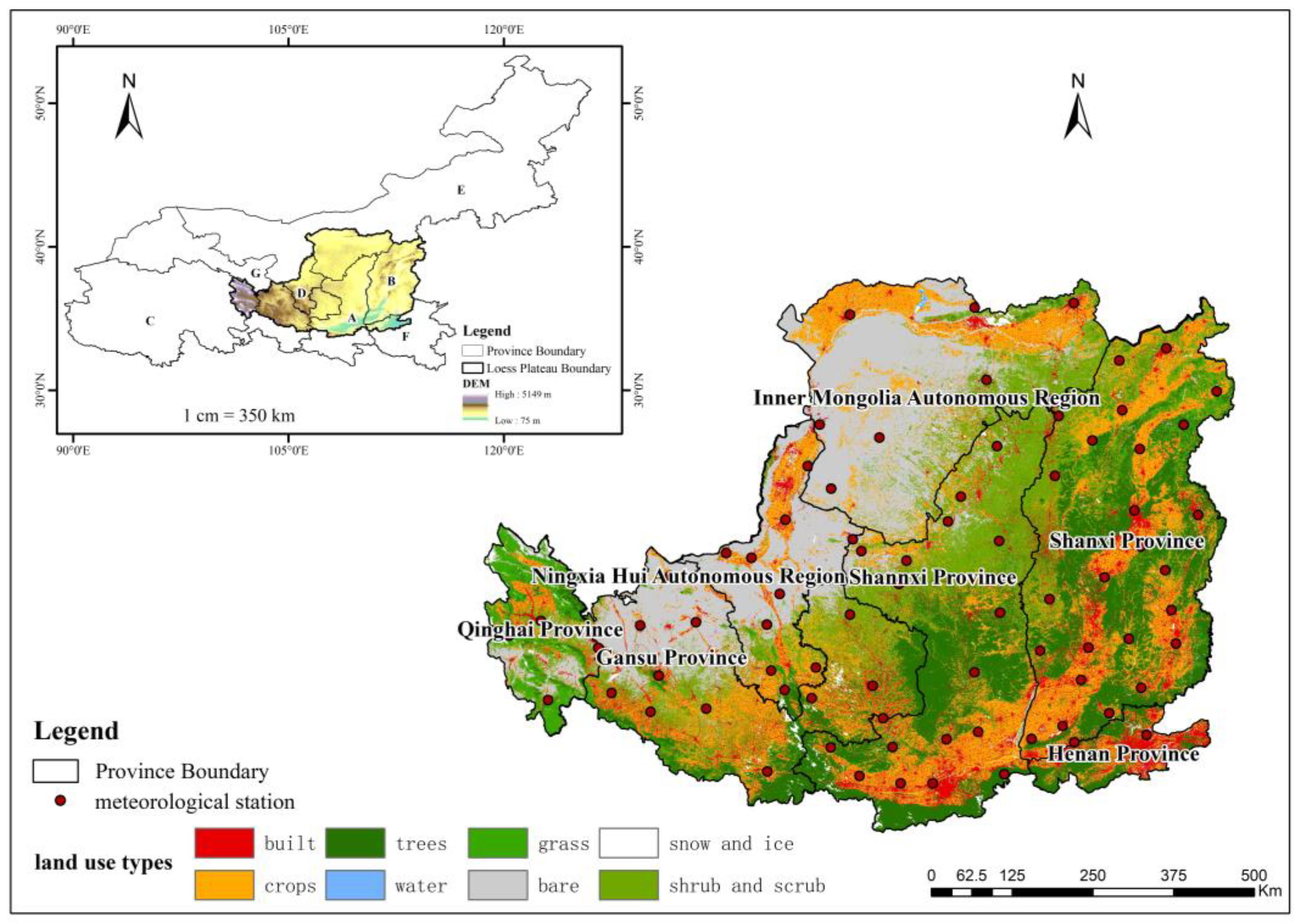
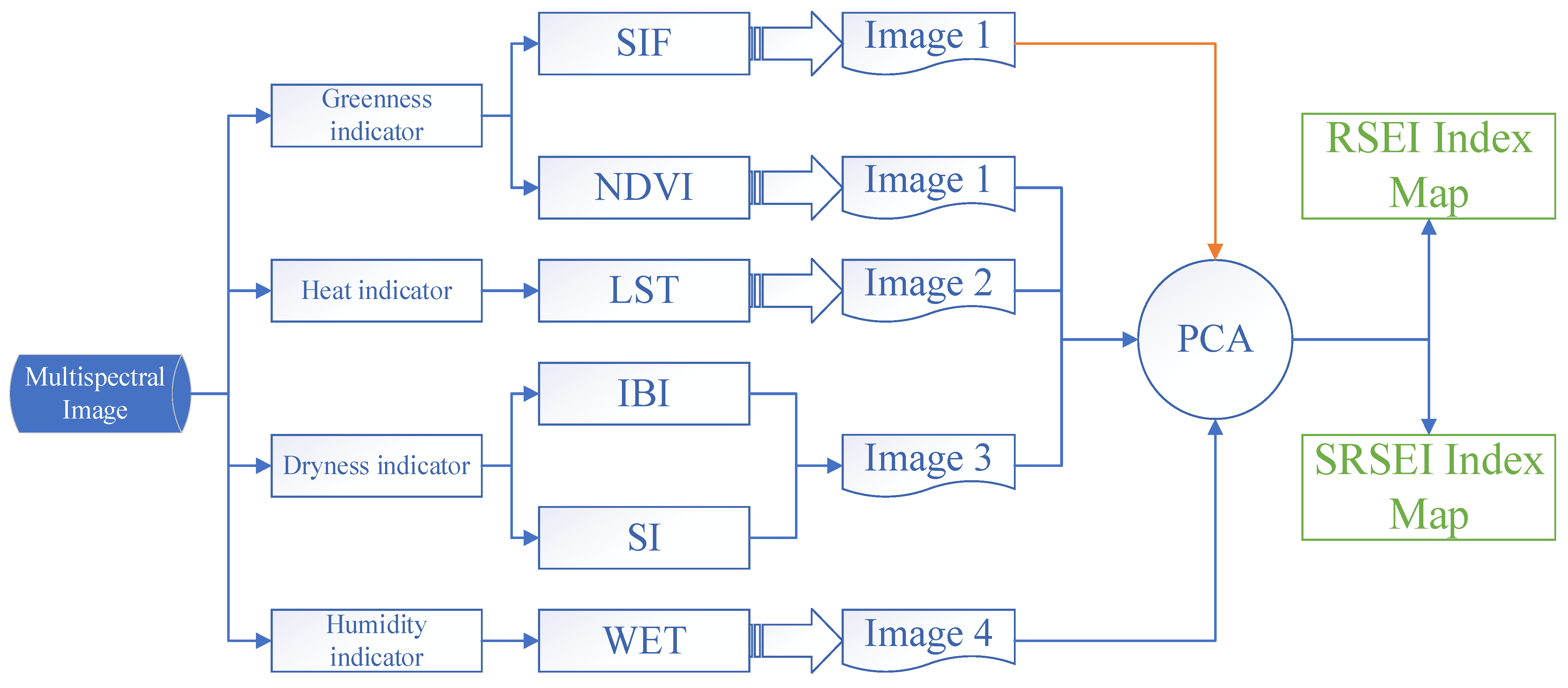
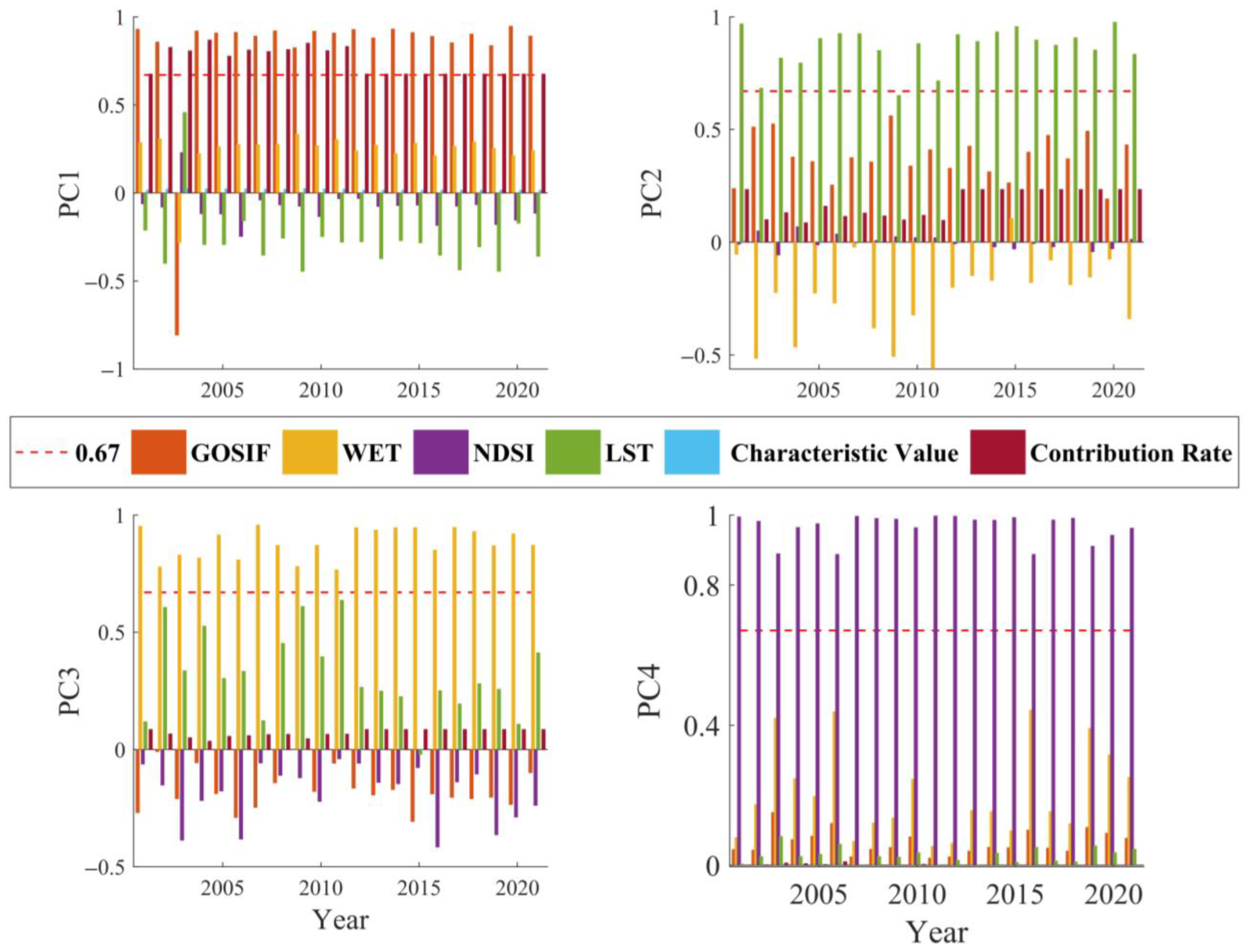
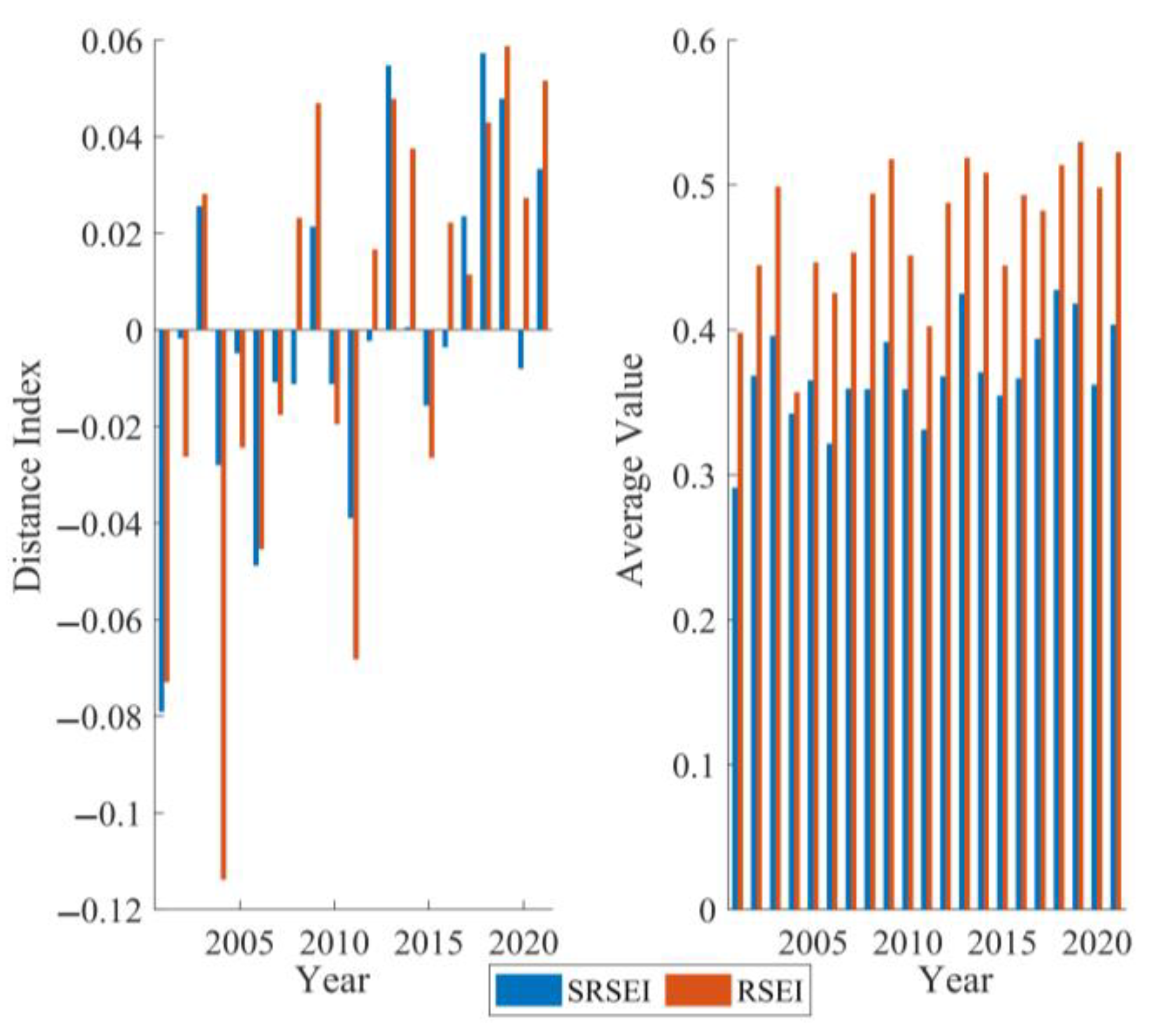
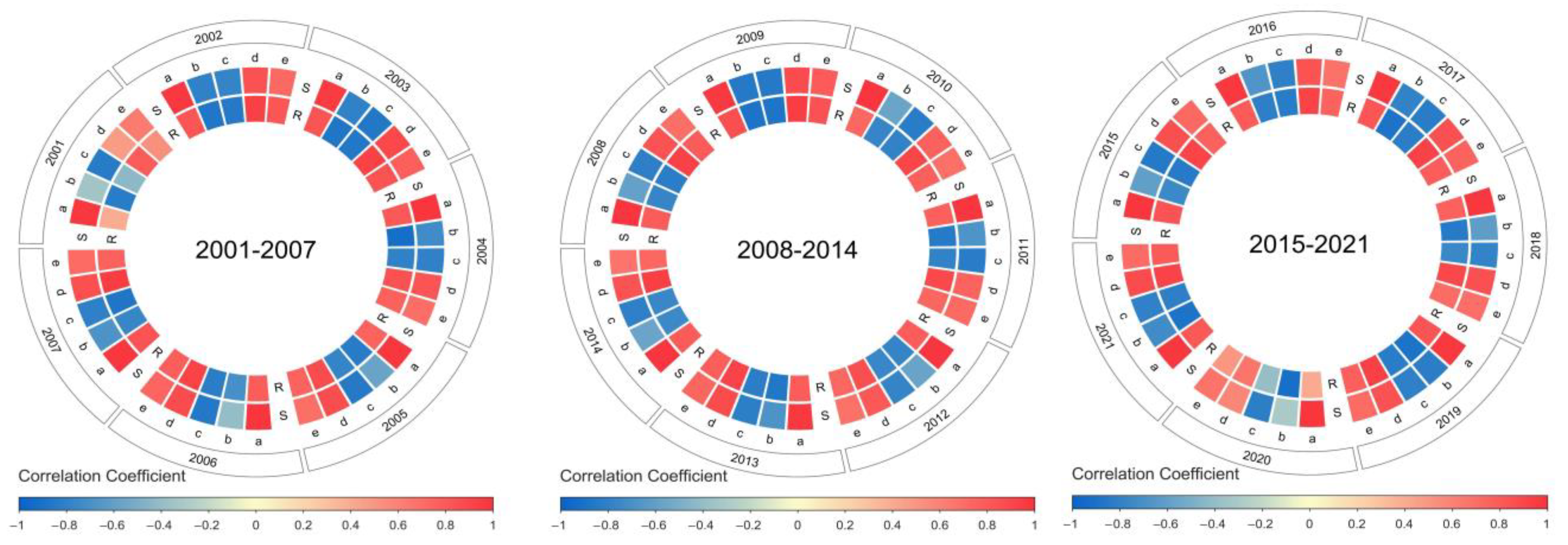
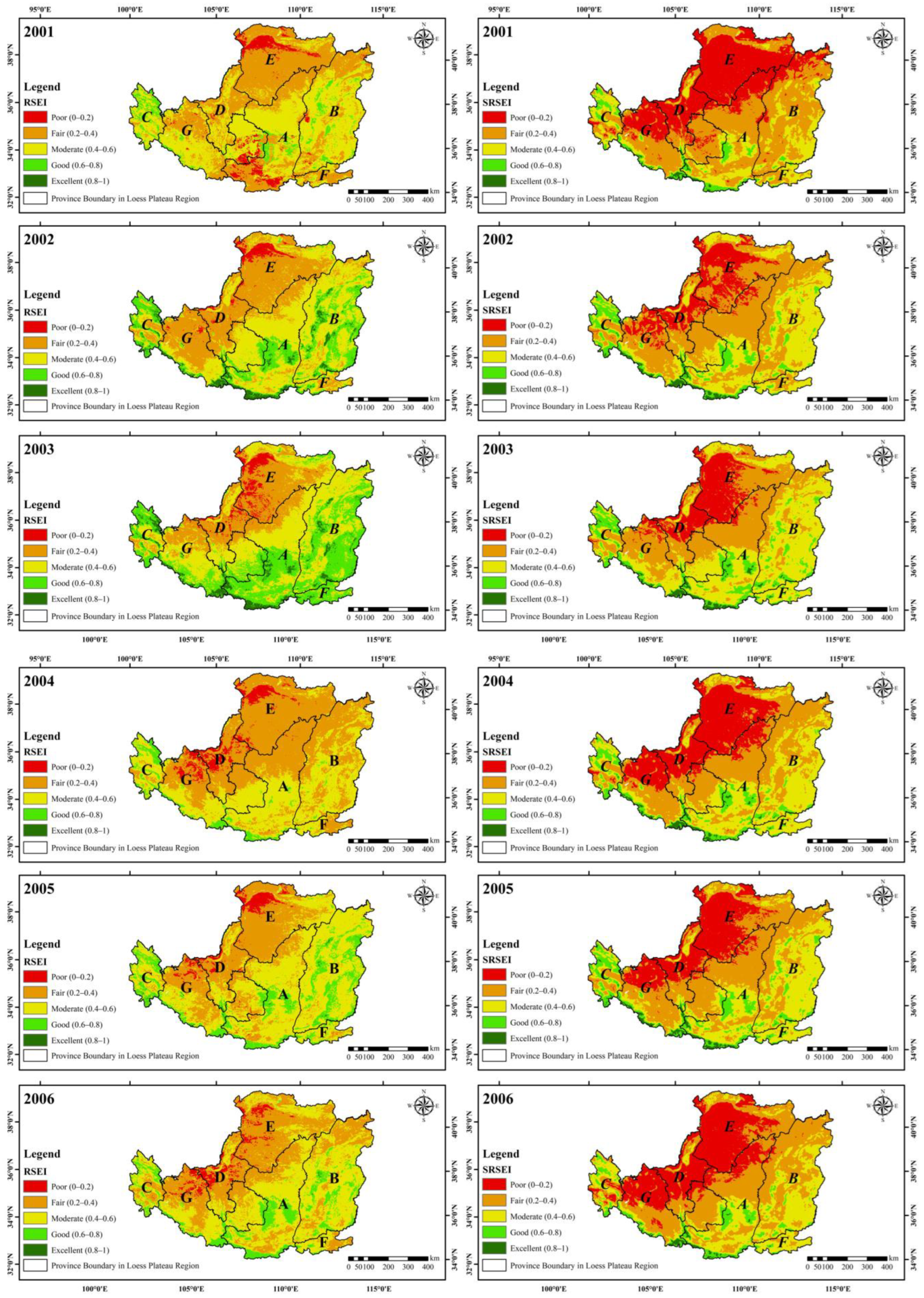

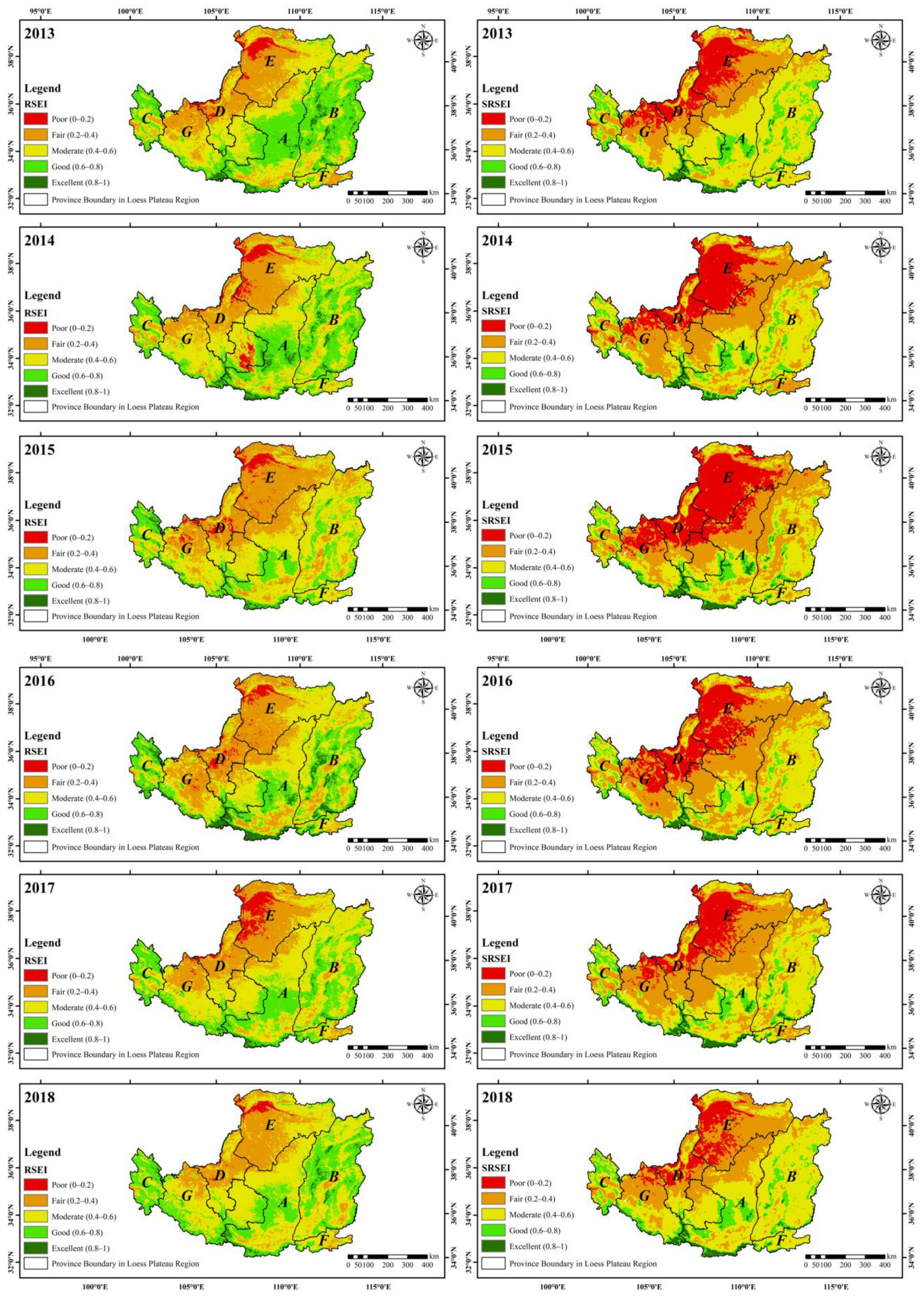
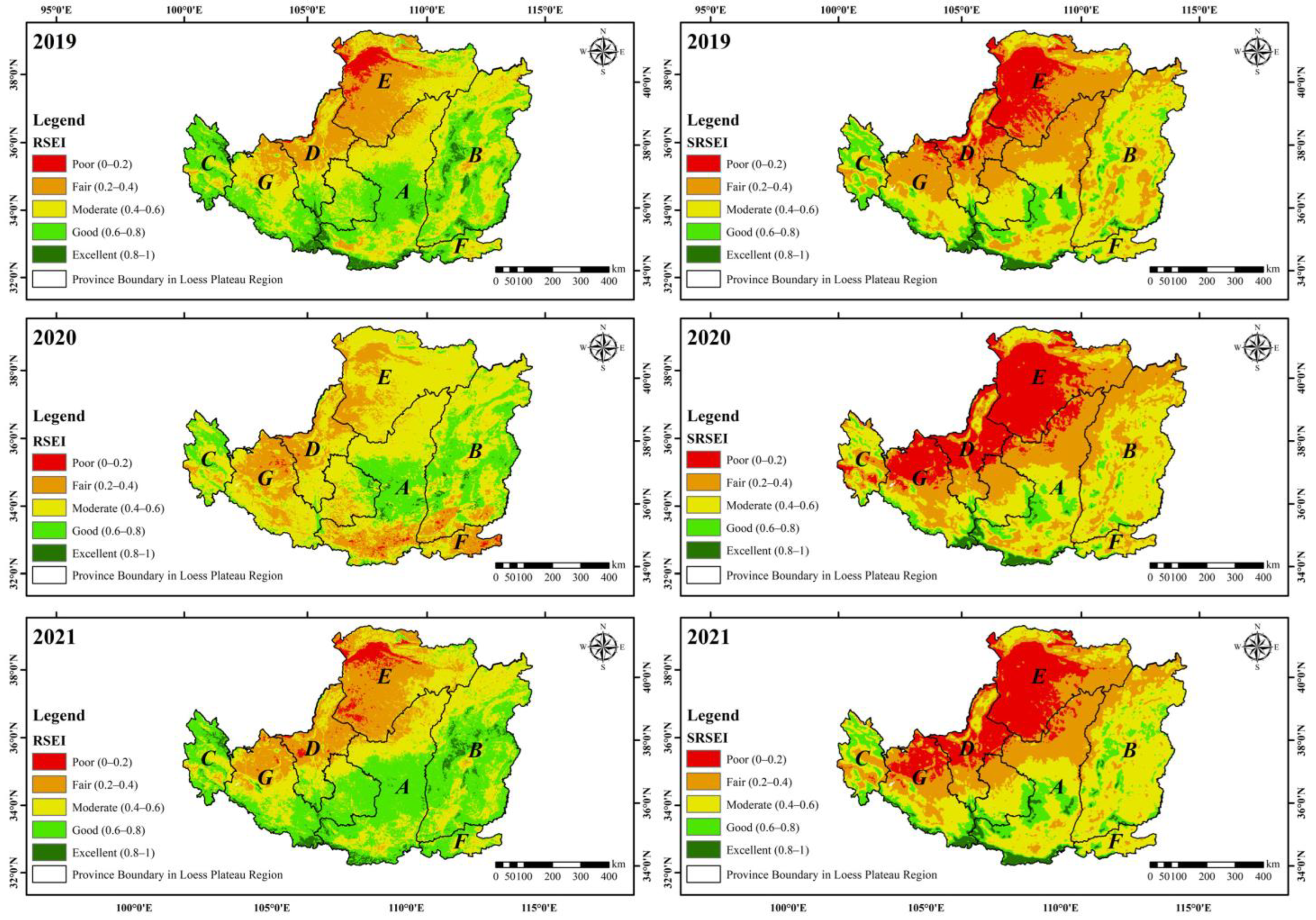
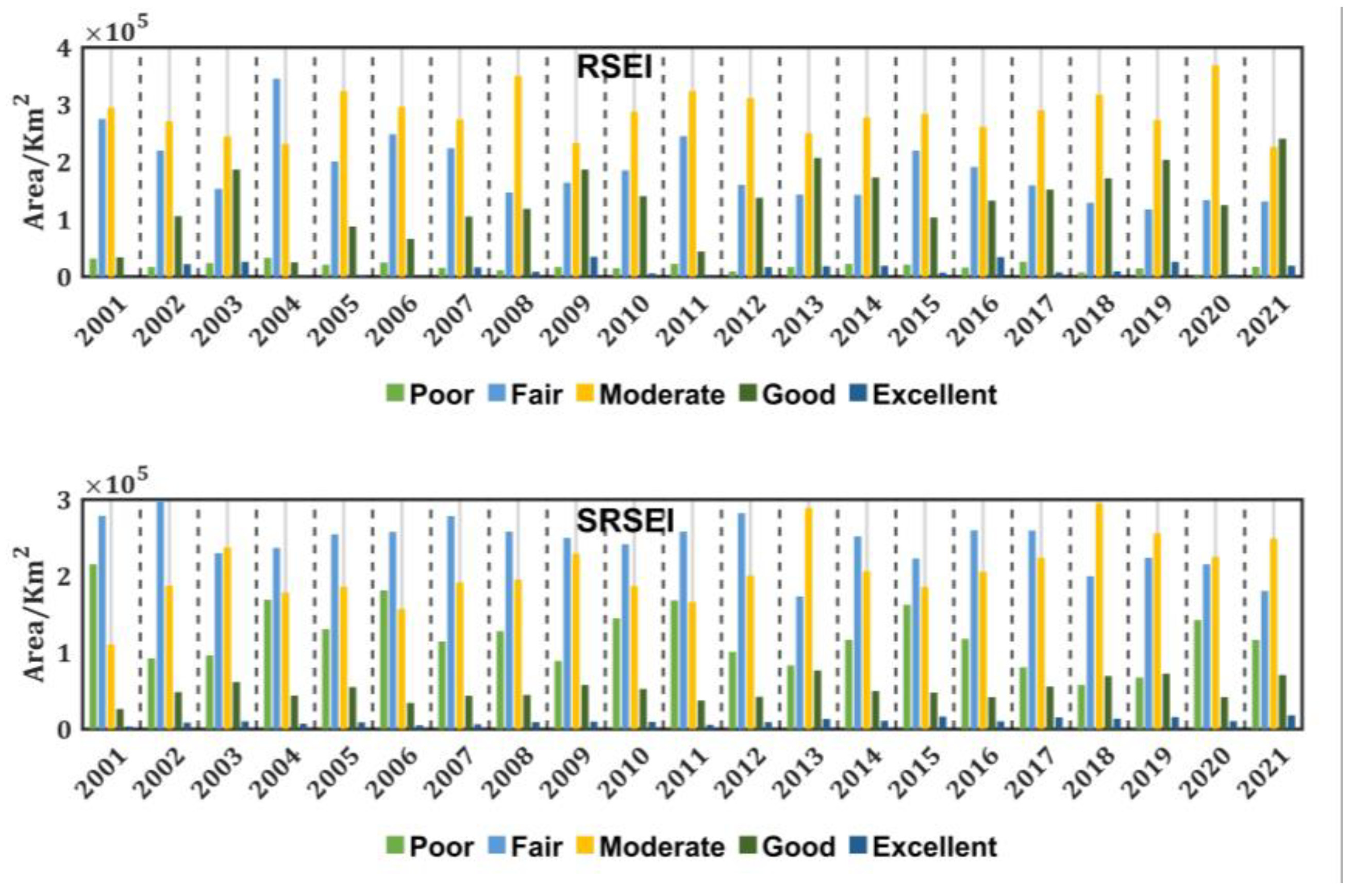
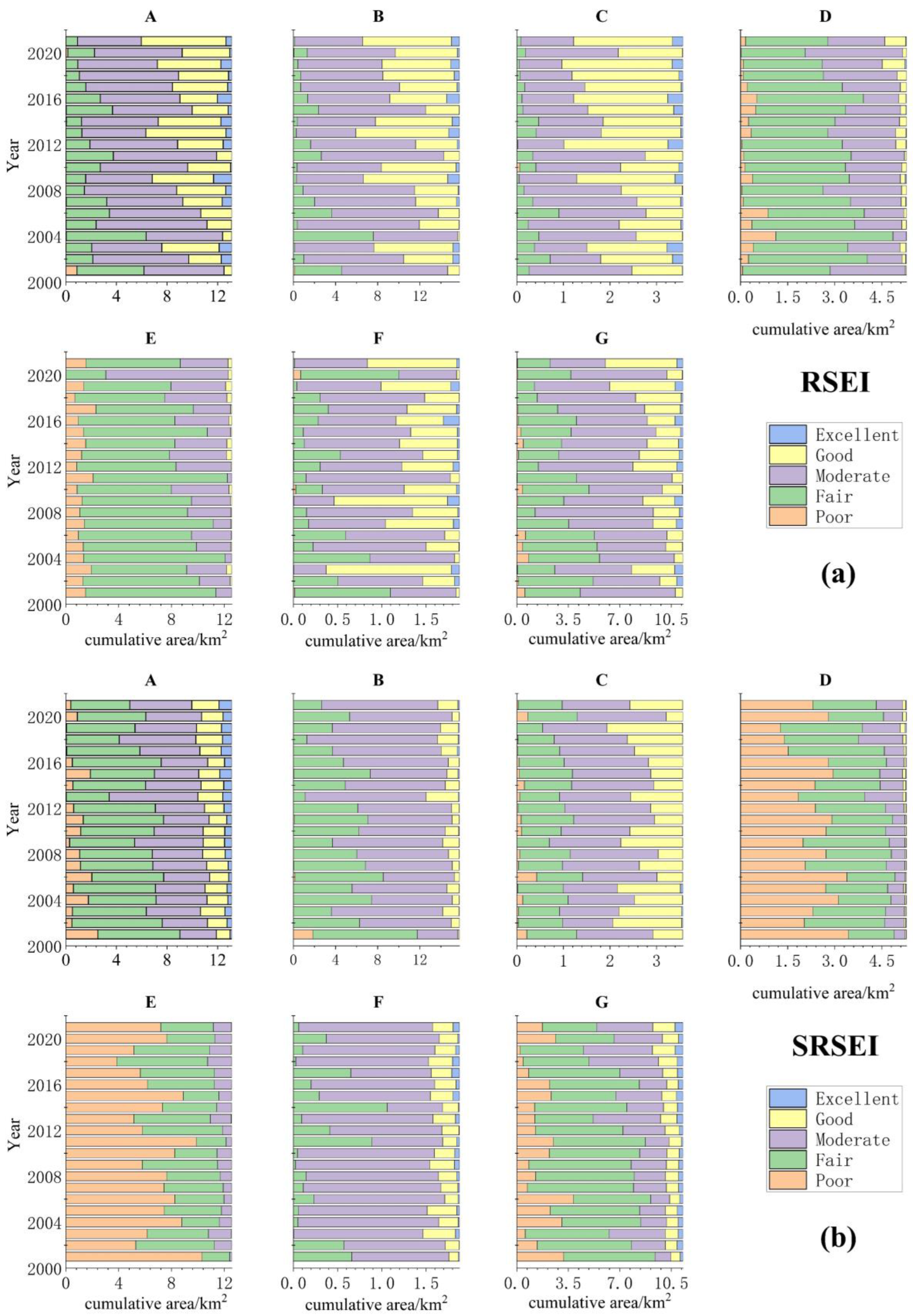
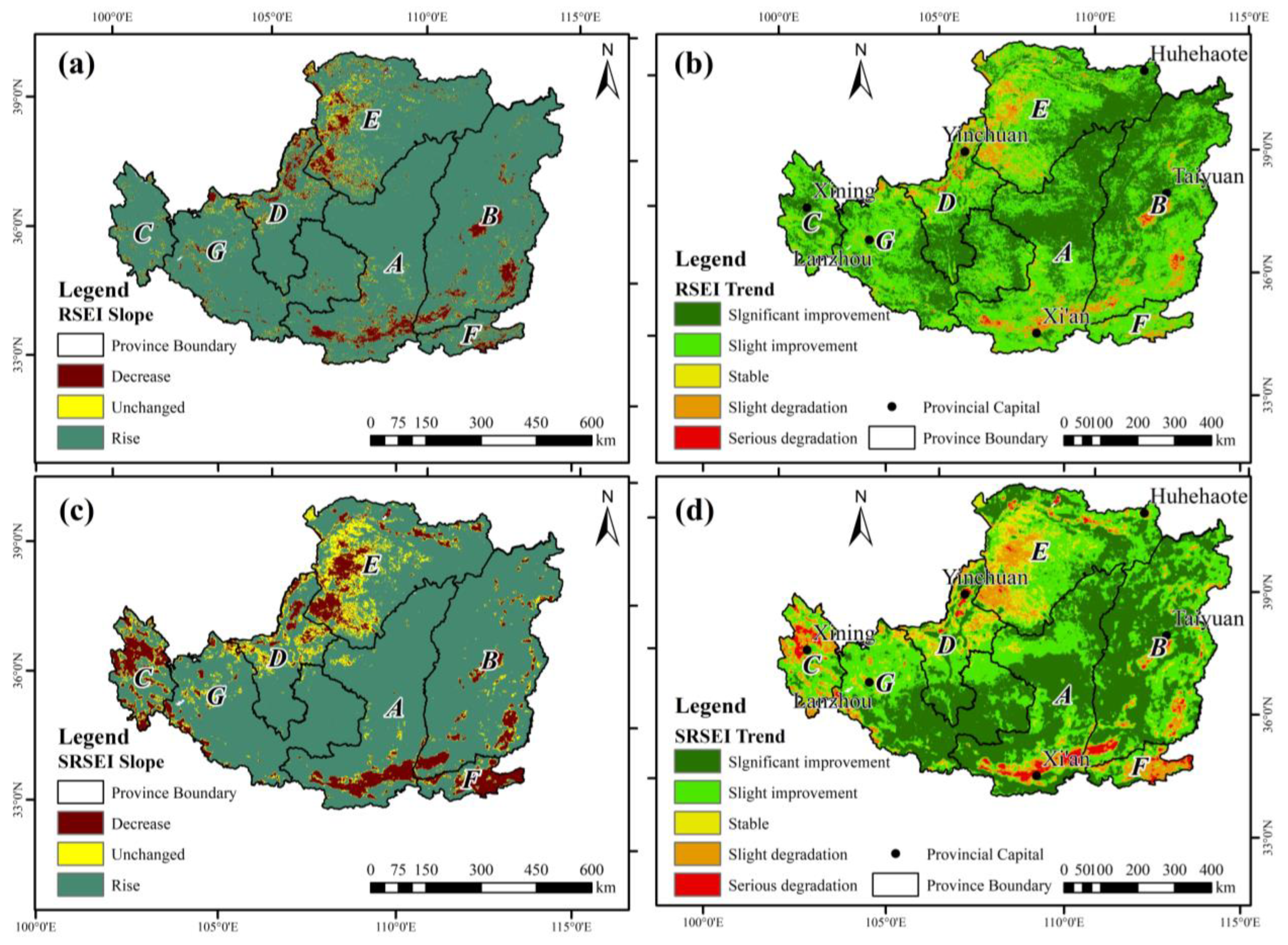
| Satellite Data | Parameter | Temporal Resolution | Spatial Resolution |
|---|---|---|---|
| MOD09A1 | Reflectance products | 8 day | 500 m |
| MOD11A2 | Surface temperature | 8 day | 500 m |
| MOD13A1 | Vegetation indices | 16 day | 500 m |
| GOSIF | SIF | 30 day | 500 m |
| Year | 2001 | 2002 | 2003 | 2004 | 2005 | 2006 | 2007 | 2008 | 2009 | 2010 | 2011 |
|---|---|---|---|---|---|---|---|---|---|---|---|
| Difference | 0.107 | 0.076 | 0.103 | 0.015 | 0.081 | 0.104 | 0.094 | 0.135 | 0.126 | 0.092 | 0.071 |
| Year | 2012 | 2013 | 2014 | 2015 | 2016 | 2017 | 2018 | 2019 | 2020 | 2021 | |
| Difference | 0.120 | 0.094 | 0.138 | 0.090 | 0.127 | 0.089 | 0.086 | 0.112 | 0.136 | 0.119 |
| Index/Year | 2001 | 2002 | 2003 | 2004 | 2005 | 2006 | 2007 | 2008 | 2009 |
|---|---|---|---|---|---|---|---|---|---|
| RSEI | 0.05 | 0.24 | 0.55 | 0.4 | 0.58 | 0.44 | 0.39 | 0.27 | 0.59 |
| SRSEI | 0.16 | 0.2 | 0.56 | 0.51 | 0.65 | 0.54 | 0.51 | 0.39 | 0.58 |
| Index/Year | 2010 | 2011 | 2012 | 2013 | 2014 | 2015 | 2016 | 2017 | 2018 |
| RSEI | 0.42 | 0.49 | 0.42 | 0.51 | 0.39 | 0.39 | 0.33 | 0.49 | 0.46 |
| SRSEI | 0.56 | 0.53 | 0.35 | 0.44 | 0.45 | 0.52 | 0.34 | 0.43 | 0.47 |
Disclaimer/Publisher’s Note: The statements, opinions and data contained in all publications are solely those of the individual author(s) and contributor(s) and not of MDPI and/or the editor(s). MDPI and/or the editor(s) disclaim responsibility for any injury to people or property resulting from any ideas, methods, instructions or products referred to in the content. |
© 2023 by the authors. Licensee MDPI, Basel, Switzerland. This article is an open access article distributed under the terms and conditions of the Creative Commons Attribution (CC BY) license (https://creativecommons.org/licenses/by/4.0/).
Share and Cite
Shi, M.; Lin, F.; Jing, X.; Li, B.; Shi, Y.; Hu, Y. Ecological Environment Quality Assessment of Arid Areas Based on Improved Remote Sensing Ecological Index—A Case Study of the Loess Plateau. Sustainability 2023, 15, 13881. https://doi.org/10.3390/su151813881
Shi M, Lin F, Jing X, Li B, Shi Y, Hu Y. Ecological Environment Quality Assessment of Arid Areas Based on Improved Remote Sensing Ecological Index—A Case Study of the Loess Plateau. Sustainability. 2023; 15(18):13881. https://doi.org/10.3390/su151813881
Chicago/Turabian StyleShi, Ming, Fei Lin, Xia Jing, Bingyu Li, Yang Shi, and Yimin Hu. 2023. "Ecological Environment Quality Assessment of Arid Areas Based on Improved Remote Sensing Ecological Index—A Case Study of the Loess Plateau" Sustainability 15, no. 18: 13881. https://doi.org/10.3390/su151813881
APA StyleShi, M., Lin, F., Jing, X., Li, B., Shi, Y., & Hu, Y. (2023). Ecological Environment Quality Assessment of Arid Areas Based on Improved Remote Sensing Ecological Index—A Case Study of the Loess Plateau. Sustainability, 15(18), 13881. https://doi.org/10.3390/su151813881






